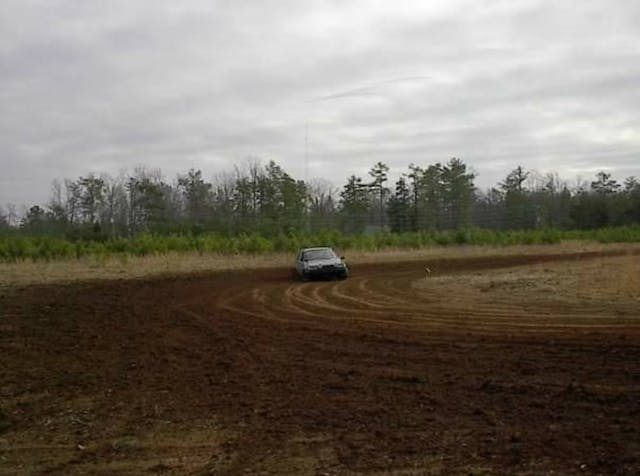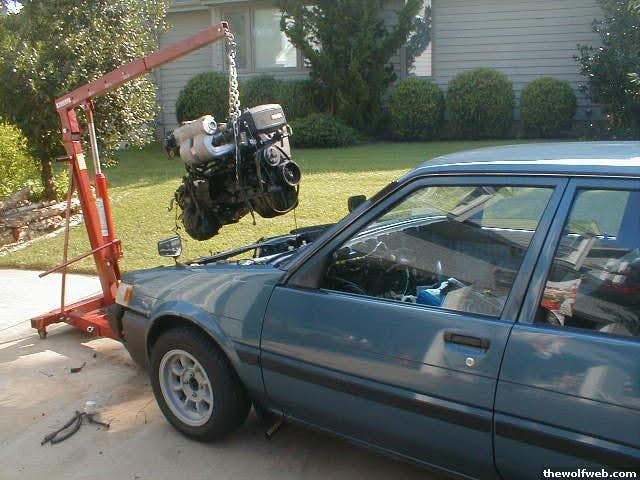The track-prepped Corolla I never should have crushed
Matthew Anderson is an American engineer who relocated to Germany a few years ago for work. In his spare time, with reckless abandon, he pursues a baffling obsession with unexceptional Eastern Bloc cars. We don’t ask him too many follow-up questions.
Most of us recall at least one vehicle that we never should have let slip through our fingers. Whether we sold it in a moment of weakness or simply let it fall into disrepair through the persistent creep of neglect, letting go can mean regret down the road. My first car, an AMC Javelin, certainly comes to mind. So does my crusty, banana-pudding-yellow Simca 1204 (a story for another time). Alas, none leave me feeling hollow quite like the dirty old Toyota Corolla I drove daily, raced, and bonded with all the way to its forever home: the scrapper.

I was about 16 years old, and the year was 2001. As my learner’s permit had nearly ripened into a full driver’s license, it was becoming clear that neither of my vehicles—a six-cylinder AMC Javelin and Studebaker Gran Turismo Hawk—would be anywhere close to roadworthy in time for my final driver’s exam. Perhaps sensing this exclusively with the keen faculties of his subconscious, my father cracked open the tap of trickle-down vehicular economics just in time for the big day. Initially intending to buy a 1962 Oldsmobile Starfire at an auction at the so-called Jim-damn-Graham building in downtown Raleigh, Dad was ultimately outbid. But auction fever had already struck, and a couple lots later he was a moth to the bright “Chrome Yellow” flame of a 1998 Mustang Cobra.
We rode home in relative silence aside from the drone of a 32-valve modular motor.
Once the domestic explosion at home subsided to embers and things were back to normal, the resulting nuclear chain reaction produced a silver ’96 GT for my older brother. That displaced his lowly blue-on-blue plaid, 74-horsepower, carbureted 1986 Toyota Corolla sedan onto my feet. At the time, the only good I saw in it was it was still running (despite my brother’s diligent efforts), had three pedals, and a strong handbrake.

It wasn’t too long before my Saturn of Raleigh friends and coworkers, Jordan and Adam, convinced me to bring it to a local autocross with the Tarheel Sports Car Club. I naively trusted them, and why shouldn’t I have? Jordan had an E30 with a roll bar and Adam once called AAA to drag a sap- and pine-needle-encrusted Alfa GTV6 from the woods to his house. My people!
The old Corolla and I were a good match, if I’m being honest. In the summer heat at Laurinburg-Maxton airport, I eked out an H-stock class win on 155/80/13 tires. And it kept happening! Each race I would flick, slide, and hammer through cone gates on the bump stops to a first or second place, eventually taking H-stock season trophy in our small, local club.
Deciding that the car needed to be a bit nimbler, I explored what could be done to stiffen it up and make it rotate a bit more quickly. (Without consulting the rulebook, naturally.) At the time, the only aftermarket support available for the AE82-gen Corolla platform was out of Japan or Australia. After a very early morning phone call to Whiteline in New South Wales I had a full set of poly bushings on the way. Onto the springs: help came via Eibach and Ground Control, the latter of which instructed me to make a crude drawing of the strut top hat and mail it to them. A set of camber plates and hats were crossed to a Mitsubishi Lancer and fitted following a bit of banging and filing work on my end. Ground Control also hooked me up with a spring recommendation for the adjustable coil overs: 400 lb/in at the front and 275 lb/in at the rear. Now I had fully configurable alignment, less compliance, and decent springs. However, with practically every available shock option touting “Maximum Comfort” and “Ride Control” descriptions, nothing off the shelf seemed acceptable. A quick trip to the junkyard yielded a set of Camry struts that I gutted, re-drilled, and shortened to accept a later, AE92-generation cartridge from Koni. Given serious limitations in suspension travel at the ride height I wanted, it was far from good but an improvement nonetheless. After some time spent on borrowed corner scales and with a tape-measure alignment in a barn, the ‘Rolla was dialed in for autocross. For emergency trackside adjustments, I threw in a brake balance adjuster for good measure.
To my dismay, I was completely uncompetitive in both street-prepared or modified classes against late-model Camaros and Firebird WS6s.

The idea to do something radical followed a spirited, inside-rear-wheel-lifting drive in Adam’s 16V-swapped Rabbit GTI. It was clear I needed a bit more power, whatever the source. The car was originally equipped with a single-overhead-cam 1.6-liter carbureted four making about 74 hp and revving out to 6000 rpm. I started researching what to do online but in the days of first-wave-animated-GIFs, the resources were damned limited. There was some support out of Puerto Rico for the build-up on the single-cam motor but it seemed like astronomical work for a grand total of 100 hp. Sixteen valves it would be, and preferably as easily as possible.
A path forward was gradually coming clear: Some Australian guy named Bill Sherwood provided a depth of information on building up the Toyota 1.6-liter Twin-Cam 4A-GE motor and there was an ambulance driver on the West Coast who had swapped this same motor into a sedan like mine, but he was running double 40-mm DCOE Webers with some oddball distributor swap. I decided that the best way was actually the familiar way—the junkyard—where I could snag every last bit and bob needed to install a fuel-injected 4A-GE. After school one day, I started making calls and asking if they happen to have a comparatively rare ’85-88 MR2, Corolla FX16, Geo Prism GSi, or any kind of Corolla GT-S. Drive configuration didn’t matter, I just needed a motor. “Sure, son. We’ve got a mess ‘a Corollas” was the common answer. In-person visits were clearly in order.

After visiting T.E. Nine’s, Nine’s Auto Salvage (they’re different), Bullock’s, Martin’s, Martin’s Import, and some sketchy place in Wake Forest that didn’t have a name, I headed out to Jackson’s Auto Salvage. It’s probably a subdivision now, but back then it was a one of the many diversely stocked junkyards in Raleigh. They let me wander around in the “import” section until I stumbled upon the ideal donor: a sun-baked and pink oxidized 1986 Corolla FX-16 sitting hubs deep in a mud puddle. A quick prod around and I had already amassed a list of things to steal: Engine, trans, ECU, wiring, vented front discs with calipers and brackets, rear disc brake conversion, gauge cluster, body reinforcements, front and rear sway bars, and an equalizer. This was getting … expensive. Better go inside to try to negotiate something.
My presentation of the desired list (juvenile explanation included) to the counter clerk went as follows: “I only have $200 and …” from there he interrupted so as to direct me straight the boss man. They closed the door behind me. On the wood-paneled wall hung a cross-stitched message that read, “It’s nice to be important. But it’s more important to be nice.” Things were looking good!
“Siddown, son. So what exactly did you have in mind?” he asked me over the top of a large mason-jar-turned-tobacco-spittoon. Over that foamy brown muck, bossman lived up to his cross-stitched mantra. We struck a deal to strip the car the next day after school for $250. I packed my brother’s Trooper with everything that would fit and drove straight to the pressure wash bays of the Saturn dealership.
My elation was short-lived. I noticed a curious hole underneath the A/C bracket. Not the clean circular kind with threads, either. Dropping the pan brought with it half of the rotating assembly, so I promptly called the boss man back. I didn’t even have to invoke the crochet. He concurred that three connecting rods indeed should not be in the windage tray and organized for the motor from a neighboring silver ’85 MR2 to be waiting for me after the school bell rang. Quelle service!

Funds were tight, so I had to allocate my car-washing money accordingly. $400 on a lightweight flywheel, $250 on a beefy clutch, a head gasket set, and Toyota oil pan sealant was the list of afforded luxuries. The rest would have be a fiscally-limited dice roll. With the parts waiting, I ripped out the motor, gearbox, dash, brakes, and suspension as it sat under our basketball hoop. You can understand why our HOA already had letters pre-stamped with “Anderson” in the event these shenanigans dragged on at all, so the Corolla needed to be back on its wheels in a week or so. Seeing the bare firewall and two wiring harnesses lying next to each other on the driveway did not inspire my confidence. How does one, I wondered, put the silly string back in the can? Somehow I managed to drop in the motor, and a stolen in-line fuel pump from a friend’s crashed E30 locked in the final piece of the puzzle. Thanks to a favorable alignment of all relevant celestial bodies, crossed fingers from all requested parties, and years of dutifully eating collards on New Year’s Day had yielded an unanticipated result: the car ran! And, because the collards came with gravy, it was fast all the way to its 7800-rpm redline.

With newfound power, the Corolla graduated from autocross to track days at Virginia International Raceway, Carolina Motorsport Park, Roebling Road, and other race tracks across the South. The car’s primary role was to scare myself and instructors shitless with once-unthinkable front straight speeds, particularly with the door frames buffeting against the body. Over the next 18 months, I replaced the gearbox and added a TRD Torsen limited slip after the original blew up. Then the motor burned valves due to my ignorance of relevant adjustment protocols, necessitating use of a junkyard rig that lasted most of a weekend before losing oil pressure in the downhill corkscrew at VIR South Course. On the drive home, I was stopped at a checkpoint in Person County, North Carolina. As the officer and I chatted amid a choppy idle and the glow of a red oil pressure lamp, he told me “son, you’re braver than I am,” as he tore off a ticket for my lapsed inspection.
The next day, the Toyota passed emissions despite a clamoring rod knock that would render it once again engineless. Over the next few weeks, I drove my Studebaker while I built a bottom end for the Corolla (using black top 20V parts, for you 4AG freaks) with 11:1 compression, a blue top head with cams (and properly adjusted valves), and I swapped the LSD into a closer ratio five-speed from Japan. With about 160 horsepower, it positively screamed. It ran quite well until I crashed it on a test ride by cresting a hill on dry-rotted Hoosiers. In the process I managed to rear-end an S-10 whose pilot fell asleep while waiting to turn left. We mutually agreed to let the incident pass unreported. In preparation for my upcoming track day at Roebling Road in Georgia, I folded in about 100 pounds of weight savings work into my overnight rebuild. The car was getting faster, lighter, and much cruder. Ah, the recklessness of youth.

The Corolla’s downfall—which you’ll remember started with a hastily repaired collision—had devolved into an uncontrollable death spiral of small and medium-sized failures. In the weeks before heading on a semester abroad to Melbourne, I (somewhat accidentally) jumped it and cracked the rear-mounted battery in half. The front wheel bearings failed due to a crack in the bearing carrier that corresponded perfectly with the steering axis. It would simply spit out the outer race after a couple weeks.
This was the beginning of the end. To nobody’s surprise, me spending eight months in Australia didn’t help repair the car. After returning from Down Under, I was burned out on track days and just needed a car. A non-running, track-optimized Corolla wouldn’t get me to my internship on time. Gradually, I sold off bits until one day I put the bailing forks of an International 856 through the door frames and loaded it on the scrap trailer. Thinking about it today causes me physical pain.

I do occasionally cruise various online marketplaces for another AE82. Do I really need another one? No. But what if a one-owner, five-speed, 8A9 Toyota Corolla sedan popped up, finished in beautiful blue metallic paint? We all know what would happen. Would I keep it stock? Maybe. But I’d keep it forever.

